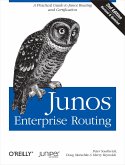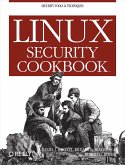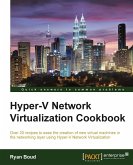Aviva Garrett
JUNOS Cookbook
Aviva Garrett
JUNOS Cookbook
- Broschiertes Buch
- Merkliste
- Auf die Merkliste
- Bewerten Bewerten
- Teilen
- Produkt teilen
- Produkterinnerung
- Produkterinnerung
The Juniper Networks routing platforms are becoming the go-to solution for core, edge, metro and remote office networks, and JUNOS software is behind it all. The operating system is so full of industrial-strength routing protocols and IP innovations that those treading into the world of JUNOS will need clarification, explanation, and a showcase example or two. Look no further. This JUNOS Cookbook provides it all and more.
Yes, you can mine through the 5,000 pages of documentation or take a two-thousand-dollar training course, but JUNOS's interprocess sophistication can be baffling unless…mehr
Andere Kunden interessierten sich auch für
![Junos Enterprise Routing Junos Enterprise Routing]() Peter SouthwickJunos Enterprise Routing76,99 €
Peter SouthwickJunos Enterprise Routing76,99 €![JUNOS Automation Cookbook JUNOS Automation Cookbook]() Adam ChappellJUNOS Automation Cookbook53,99 €
Adam ChappellJUNOS Automation Cookbook53,99 €![Junos Security Junos Security]() Rob CameronJunos Security80,99 €
Rob CameronJunos Security80,99 €![Linux Security Cookbook Linux Security Cookbook]() Daniel J. BarrettLinux Security Cookbook43,99 €
Daniel J. BarrettLinux Security Cookbook43,99 €![Netzwerke mit Windows 11 - für Zuhause und Selbstständige Netzwerke mit Windows 11 - für Zuhause und Selbstständige]() Christian ImmlerNetzwerke mit Windows 11 - für Zuhause und Selbstständige29,90 €
Christian ImmlerNetzwerke mit Windows 11 - für Zuhause und Selbstständige29,90 €![Hyper-V Network Virtualization Cookbook Hyper-V Network Virtualization Cookbook]() Ryan BoudHyper-V Network Virtualization Cookbook57,99 €
Ryan BoudHyper-V Network Virtualization Cookbook57,99 €![A System V Guide to UNIX and XENIX A System V Guide to UNIX and XENIX]() Douglas W. TophamA System V Guide to UNIX and XENIX82,99 €
Douglas W. TophamA System V Guide to UNIX and XENIX82,99 €-
-
-
The Juniper Networks routing platforms are becoming the go-to solution for core, edge, metro and remote office networks, and JUNOS software is behind it all. The operating system is so full of industrial-strength routing protocols and IP innovations that those treading into the world of JUNOS will need clarification, explanation, and a showcase example or two. Look no further. This JUNOS Cookbook provides it all and more.
Yes, you can mine through the 5,000 pages of documentation or take a two-thousand-dollar training course, but JUNOS's interprocess sophistication can be baffling unless you know the shortcuts and tricks, as well as those rays of illuminating comprehension that can come only from those who live with it. JUNOS Cookbook is the first comprehensive book about JUNOS software and it provides over 200 time-saving step-by-step techniques including discussions about the processes and alternative ways to perform the same task. It's been tested and tech-reviewed by field engineers who know how to take JUNOS out for a spin and it's applicable to the entire line of M-, T-, and J-series routers. JUNOS Cookbook will not only pay for itself the first few times you use it, it will make your network easier to manage and update.
"Aviva Garrett has done a tremendous job of distilling the features of JUNOS software in a form that will be useful for a wide audience-students, field engineers, network architects, and other networking professionals alike will benefit from this book. For many people, this is the only book on JUNOS they will need." -- Pradeep Sindhu, CTO and Founder, Juniper Networks
"This cookbook is superb. Aviva Garrett has masterfully assembled a complete set of practical real-world examples with step-by-step instructions. Security, management, routing: it's all here!" -- Stephen Gill, Research Fellow, Team Cymru
"A technical time-saver for any NOC or SOC working with JUNOS. It's clear, concise, and informative recipes are are an invaluable resource." -- Scott A. McIntyre, Security Officer, XS4ALL Internet B.V
Hinweis: Dieser Artikel kann nur an eine deutsche Lieferadresse ausgeliefert werden.
Yes, you can mine through the 5,000 pages of documentation or take a two-thousand-dollar training course, but JUNOS's interprocess sophistication can be baffling unless you know the shortcuts and tricks, as well as those rays of illuminating comprehension that can come only from those who live with it. JUNOS Cookbook is the first comprehensive book about JUNOS software and it provides over 200 time-saving step-by-step techniques including discussions about the processes and alternative ways to perform the same task. It's been tested and tech-reviewed by field engineers who know how to take JUNOS out for a spin and it's applicable to the entire line of M-, T-, and J-series routers. JUNOS Cookbook will not only pay for itself the first few times you use it, it will make your network easier to manage and update.
"Aviva Garrett has done a tremendous job of distilling the features of JUNOS software in a form that will be useful for a wide audience-students, field engineers, network architects, and other networking professionals alike will benefit from this book. For many people, this is the only book on JUNOS they will need." -- Pradeep Sindhu, CTO and Founder, Juniper Networks
"This cookbook is superb. Aviva Garrett has masterfully assembled a complete set of practical real-world examples with step-by-step instructions. Security, management, routing: it's all here!" -- Stephen Gill, Research Fellow, Team Cymru
"A technical time-saver for any NOC or SOC working with JUNOS. It's clear, concise, and informative recipes are are an invaluable resource." -- Scott A. McIntyre, Security Officer, XS4ALL Internet B.V
Hinweis: Dieser Artikel kann nur an eine deutsche Lieferadresse ausgeliefert werden.
Produktdetails
- Produktdetails
- Verlag: O'Reilly Media
- Seitenzahl: 682
- Erscheinungstermin: 23. Mai 2006
- Englisch
- Abmessung: 233mm x 179mm x 43mm
- Gewicht: 1155g
- ISBN-13: 9780596100148
- ISBN-10: 0596100140
- Artikelnr.: 20786524
- Herstellerkennzeichnung
- Libri GmbH
- Europaallee 1
- 36244 Bad Hersfeld
- gpsr@libri.de
- Verlag: O'Reilly Media
- Seitenzahl: 682
- Erscheinungstermin: 23. Mai 2006
- Englisch
- Abmessung: 233mm x 179mm x 43mm
- Gewicht: 1155g
- ISBN-13: 9780596100148
- ISBN-10: 0596100140
- Artikelnr.: 20786524
- Herstellerkennzeichnung
- Libri GmbH
- Europaallee 1
- 36244 Bad Hersfeld
- gpsr@libri.de
Aviva Garrett has documented Juniper Networks technologies since joining the company as its first writer in 1997. She wrote the first JUNOS manuals and then oversaw the documentation as the company grew from a startup to an established network equipment provider. She recently stepped down as Juniper Networks' Director of Tech Pubs to pursue other writing and business assignments, such as this book. Prior to Juniper Networks, Aviva worked at Cisco Systems for six years. She also worked for Novell, Saber Technologies, Gavilan, and other technology companies and startups. She is the co-author of "Juniper Networks Field Guide and Reference" (2002, Addison-Wesley). Aviva is well-known in the networking industry and in networking list-serves and engineering circles.
Foreword
Preface
Organization
What's in This Book
Conventions
Comments and Questions
Safari® Enabled
Acknowledgments
Chapter 1: Router Configuration and File Management
1.1 Introduction
1.1 Configuring the Router for the First Time
1.2 Configuring the Router from the CLI
1.3 Getting Exclusive Access to Configure the Router
1.4 Displaying the Commands to Recreate a Configuration
1.5 Including Comments in the Configuration
1.6 Checking the Syntax of the Configuration
1.7 Activating the Router Configuration
1.8 Debugging a Failed Commit
1.9 Exiting Configuration Mode
1.10 Keeping a Record of Configuration Changes
1.11 Determining What Changes You Have Made to the Configuration
1.12 Configuring the Router by Copying a File from a Server
1.13 Configuring the Router by Copying Text from a Terminal Window
1.14 Backing Up the Router's Configuration
1.15 Scheduling the Activation of a Configuration
1.16 Provisionally Activating a Configuration
1.17 Loading a Previous Router Configuration
1.18 Creating an Emergency Rescue Configuration
1.19 Backing Up Filesystems on M-Series and T-Series Routers
1.20 Backing Up Filesystems on J-Series Routers
1.21 Restoring a Backed-Up Filesystem
1.22 Installing a Different Software Release on M-Series and T-Series Routers
1.23 Installing a Different Software Release on J-Series Routers
1.24 Creating an Emergency Boot Disk
1.25 Gathering Software Version Information
1.26 Gathering Hardware Inventory Information
1.27 Finding Out How Long the Router Has Been Up
1.28 Gathering Information Before Contacting Support
1.29 Managing Routers with Similar Configurations
1.30 Managing Redundant Routing Engines
1.31 Using the Second Routing Engine to Upgrade to a New Software Version
Chapter 2: Basic Router Security and Access Control
2.1 Introduction
2.1 Allowing Access to the Router
2.2 Controlling Root Authentication
2.3 Logging In to the Router's Console
2.4 Setting the Login Authentication Methods
2.5 Setting Up Login Accounts on the Router
2.6 Changing the Format of Plain-Text Passwords
2.7 Changing the Plain-Text Password Encryption Method
2.8 Creating a Login Account for Remote Authentication
2.9 Creating a Group Login Account
2.10 Customizing Account Privileges
2.11 Creating a Privilege Class that Hides Encrypted Passwords
2.12 Setting Up RADIUS User Authentication
2.13 Setting Up TACACS+ User Authentication
2.14 Restricting Inbound SSH and Telnet Access
2.15 Setting the Source Address for Telnet Connections
2.16 Creating a Login Banner
2.17 Finding Out Who Is Logged In to the Router
2.18 Logging Out of the Router
2.19 Forcibly Logging a User Out
Chapter 3: IPSec
3.1 Introduction
3.1 Configuring IPSec
3.2 Configuring IPSec Dynamic SAs
3.3 Creating IPSec Dynamic SAs on J-Series Routers or Routers with AS PICs
3.4 Using Digital Certificates to Create Dynamic IPSec SAs
Chapter 4: SNMP
4.1 Introduction
4.1 Configuring SNMP
4.2 Setting Router Information for the MIB-II System Group
4.3 Setting Up SNMP Traps
4.4 Controlling SNMP Access to the Router
4.5 Using a Firewall Filter to Protect SNMP Access
4.6 Controlling Access to Router MIBs
4.7 Extracting Software Inventory Information with SNMP
4.8 Extracting Hardware Inventory Information with SNMP
4.9 Collecting Router Operational Information with SNMP
4.10 Logging SNMP Access to the Router
4.11 Logging Enterprise-Specific Traps
4.12 Using RMON Traps to Monitor the Router's Temperature
4.13 Configuring SNMPv3
4.14 Tracking Router Configuration Changes
4.15 Setting Up SNMPv3 Traps
Chapter 5: Logging
5.1 Introduction
5.1 Turning On Logging
5.2 Limiting the Messages Collected
5.3 Including the Facility and Severity in Messages
5.4 Changing the Size of a Logging File
5.5 Clearing the Router's Logfiles
5.6 Sending Log Messages to Your Screen
5.7 Sending Logging Messages to a Log Server
5.8 Saving Logging Messages to the Other Routing Engine
5.9 Turning Off Logging
5.10 Turning On Basic Tracing
5.11 Monitoring Interface Traffic
Chapter 6: NTP
6.1 Introduction
6.1 Setting the Date and Time on the Router Manually
6.2 Setting the Time Zone
6.3 Synchronizing Time When the Router Boots
6.4 Synchronizing Time Periodically
6.5 Authenticating NTP
6.6 Checking NTP Status
Chapter 7: Router Interfaces
7.1 Introduction
7.1 Viewing Interface Status
7.2 Viewing Traffic Statistics on an Interface
7.3 Setting an IP Address for the Router
7.4 Setting the Router's Source Address
7.5 Configuring an IPv4 Address on an Interface
7.6 Configuring an IPv6 Address on an Interface
7.7 Configuring an ISO Address on an Interface
7.8 Creating an MPLS Protocol Family on a Logical Interface
7.9 Configuring an Interface Description
7.10 Choosing Primary and Preferred Interface Addresses
7.11 Using the Management Interface
7.12 Finding Out What IP Addresses Are Used on the Router
7.13 Configuring Ethernet Interfaces
7.14 Using VRRP on Ethernet Interfaces
7.15 Connecting to an Ethernet Switch
7.16 Configuring T1 Interfaces
7.17 Performing a Loopback Test on a T1 Interface
7.18 Setting Up a BERT Test on a T1 Interface
7.19 Configuring Frame Relay on a T1 Interface
7.20 Configuring a SONET Interface
7.21 Using APS to Protect Against SONET Circuit Failures
7.22 Configuring an ATM Interface
7.23 Dealing with Nonconfigurable Interfaces
7.24 Configuring Interfaces Before the PICs Are Installed
Chapter 8: IP Routing
8.1 Introduction
8.1 Viewing the Routes in the Routing Table
8.2 Viewing Routes to a Particular Prefix
8.3 Viewing Routes Learned from a Specific Protocol
8.4 Displaying the Routes in the Forwarding Table
8.5 Creating Static Routes
8.6 Blackholing Routes
8.7 Filtering Traffic Using Unicast Reverse-Path Forwarding
8.8 Aggregating Routes
8.9 Load-Balancing Traffic Flows
8.10 Adding Martian Addresses
8.11 Changing Route Preferences to Migrate to Another IGP
8.12 Configuring Routing Protocols to Restart Without Losing Adjacencies
Chapter 9: Routing Policy and Firewall Filters
9.1 Introduction
9.1 Creating a Simple Routing Policy
9.2 Changing a Route's Routing Information
9.3 Filtering Routes by IP Address
9.4 Filtering Long Prefixes
9.5 Filtering Unallocated Prefix Blocks
9.6 Creating a Chain of Routing Policies
9.7 Making Sure a Routing Policy Is Functioning Properly
9.8 Creating a Simple Firewall Filter that Matches Packet Contents
9.9 Creating a Firewall Filter that Negates a Match
9.10 Reordering Firewall Terms
9.11 Filtering Traffic Transiting the Router
9.12 Using a Firewall Filter to Count Traffic on an Interface
9.13 Logging the Traffic on an Interface
9.14 Limiting Traffic on an Interface
9.15 Protecting the Local Routing Engine
9.16 Rate-Limiting Traffic Flow to the Routing Engine
9.17 Using Counters to Determine Whether a Router Is Under Attack
Chapter 10: RIP
10.1 Introduction
10.1 Configuring RIP
10.2 Having RIP Advertise Its Routes
10.3 Configuring RIP for IPv6
10.4 Enabling RIP Authentication
10.5 Routing RIP Traffic over Faster Interfaces
10.6 Sending Version 1 Update Messages
10.7 Tracing RIP Protocol Traffic
Chapter 11: IS-IS
11.1 Introduction
11.1 Configuring IS-IS
11.2 Viewing the IS-IS Link-State Database
11.3 Viewing Routes Learned by IS-IS
11.4 Configuring IS-IS for IPv6
11.5 Configuring a Level 1-Only Router
11.6 Controlling DIS Election
11.7 Enabling IS-IS Authentication
11.8 Redistributing Static Routes into IS-IS
11.9 Leaking IS-IS Level 2 Routes into Level 1
11.10 Adjusting IS-IS Link Costs
11.11 Improving IS-IS Convergence Times
11.12 Moving IS-IS Traffic off a Router
11.13 Disabling IS-IS on an Interface
11.14 Tracing IS-IS Protocol Traffic
Chapter 12: OSPF
12.1 Introduction
12.1 Configuring OSPF
12.2 Viewing Routes Learned by OSPF
12.3 Viewing the OSPF Link-State Database
12.4 Configuring OSPF for IPv6
12.5 Configuring a Multiarea OSPF Network
12.6 Setting Up Stub Areas
12.7 Creating a Not-So-Stubby Area
12.8 Summarizing Routes in OSPF
12.9 Enabling OSPF Authentication
12.10 Redistributing Static Routes into OSPF
12.11 Adjusting OSPF Link Costs
12.12 Improving OSPF Convergence Times
12.13 Moving OSPF Traffic off a Router
12.14 Disabling OSPF on an Interface
12.15 Tracing OSPF Protocol Traffic
Chapter 13: BGP
13.1 Introduction
13.1 Configuring a BGP Session Between Routers in Two ASs
13.2 Configuring BGP on Routers Within an AS
13.3 Diagnosing TCP Session Problems
13.4 Adjusting the Next-Hop Attribute
13.5 Adjusting Local Preference Values
13.6 Removing Private AS Numbers from the AS Path
13.7 Prepending AS Numbers to the AS Path
13.8 Filtering BGP Routes Based on AS Paths
13.9 Restricting the Number of Routes Advertised to a BGP Peer
13.10 Authenticating BGP Peers
13.11 Setting Up Route Reflectors
13.12 Mitigating Route Instabilities with Route Flap Damping
13.13 Adding a BGP Community to Routes
13.14 Load-Balancing BGP Traffic
13.15 Tracing BGP Protocol Traffic
Chapter 14: MPLS
14.1 Introduction
14.1 Configuring LSPs Using LDP as the Signaling Protocol
14.2 Viewing Information and LDP-Signaled LSPs in the Routing Tables
14.3 Verifying that an LDP-Signaled LSP Is Carrying Traffic
14.4 Enabling LDP Authentication
14.5 Tracing LDP Operations
14.6 Setting Up RSVP-Signaled LSPs
14.7 Viewing Information About RSVP-Signaled LSPs in the Routing Tables
14.8 Verifying Packet Labels
14.9 Verifying that the RSVP-Signaled LSP Is Carrying Traffic
14.10 Configuring RSVP Authentication
14.11 Protecting an LSP's Path
14.12 Using Fast Reroute to Reduce Packet Loss Following a Link Failure
14.13 Automatically Allocating Bandwidth
14.14 Prioritizing LSPs
14.15 Allowing IGP Traffic to Use an LSP
14.16 Installing LSPs into the Unicast Routing Table
14.17 Tracing RSVP Operations
Chapter 15: VPNs
15.1 Introduction
15.1 Setting Up a Simple Layer 3 VPN
15.2 Viewing the VPN Routing Tables
15.3 Adding a VPN for a Second Customer
Chapter 16: IP Multicast
16.1 Introduction
16.1 Configuring PIM-SM
16.2 Manually Establishing a PIM-SM RP
16.3 Using Auto-RP to Dynamically Map RPs
16.4 Setting Up a PIM-SM Bootstrap Router
16.5 Filtering PIM-SM Bootstrap Messages
16.6 Configuring Multiple RPs in a PIM-SM Domain with Anycast RP
16.7 Configuring Multiple RPs in a PIM-SM Domain Anycast PIM
16.8 Limiting the Group Ranges an RP Services
16.9 Viewing Multicast Routes
16.10 Checking the Groups for Which a PIM-SM Router Maintains Join State
16.11 Manually Configuring IGMP
16.12 Using SSM
16.13 Connecting PIM-SM Domains Using MSDP and MBGP
16.14 Configuring PIM-DM
16.15 Tracing PIM Packets
Colophon
Preface
Organization
What's in This Book
Conventions
Comments and Questions
Safari® Enabled
Acknowledgments
Chapter 1: Router Configuration and File Management
1.1 Introduction
1.1 Configuring the Router for the First Time
1.2 Configuring the Router from the CLI
1.3 Getting Exclusive Access to Configure the Router
1.4 Displaying the Commands to Recreate a Configuration
1.5 Including Comments in the Configuration
1.6 Checking the Syntax of the Configuration
1.7 Activating the Router Configuration
1.8 Debugging a Failed Commit
1.9 Exiting Configuration Mode
1.10 Keeping a Record of Configuration Changes
1.11 Determining What Changes You Have Made to the Configuration
1.12 Configuring the Router by Copying a File from a Server
1.13 Configuring the Router by Copying Text from a Terminal Window
1.14 Backing Up the Router's Configuration
1.15 Scheduling the Activation of a Configuration
1.16 Provisionally Activating a Configuration
1.17 Loading a Previous Router Configuration
1.18 Creating an Emergency Rescue Configuration
1.19 Backing Up Filesystems on M-Series and T-Series Routers
1.20 Backing Up Filesystems on J-Series Routers
1.21 Restoring a Backed-Up Filesystem
1.22 Installing a Different Software Release on M-Series and T-Series Routers
1.23 Installing a Different Software Release on J-Series Routers
1.24 Creating an Emergency Boot Disk
1.25 Gathering Software Version Information
1.26 Gathering Hardware Inventory Information
1.27 Finding Out How Long the Router Has Been Up
1.28 Gathering Information Before Contacting Support
1.29 Managing Routers with Similar Configurations
1.30 Managing Redundant Routing Engines
1.31 Using the Second Routing Engine to Upgrade to a New Software Version
Chapter 2: Basic Router Security and Access Control
2.1 Introduction
2.1 Allowing Access to the Router
2.2 Controlling Root Authentication
2.3 Logging In to the Router's Console
2.4 Setting the Login Authentication Methods
2.5 Setting Up Login Accounts on the Router
2.6 Changing the Format of Plain-Text Passwords
2.7 Changing the Plain-Text Password Encryption Method
2.8 Creating a Login Account for Remote Authentication
2.9 Creating a Group Login Account
2.10 Customizing Account Privileges
2.11 Creating a Privilege Class that Hides Encrypted Passwords
2.12 Setting Up RADIUS User Authentication
2.13 Setting Up TACACS+ User Authentication
2.14 Restricting Inbound SSH and Telnet Access
2.15 Setting the Source Address for Telnet Connections
2.16 Creating a Login Banner
2.17 Finding Out Who Is Logged In to the Router
2.18 Logging Out of the Router
2.19 Forcibly Logging a User Out
Chapter 3: IPSec
3.1 Introduction
3.1 Configuring IPSec
3.2 Configuring IPSec Dynamic SAs
3.3 Creating IPSec Dynamic SAs on J-Series Routers or Routers with AS PICs
3.4 Using Digital Certificates to Create Dynamic IPSec SAs
Chapter 4: SNMP
4.1 Introduction
4.1 Configuring SNMP
4.2 Setting Router Information for the MIB-II System Group
4.3 Setting Up SNMP Traps
4.4 Controlling SNMP Access to the Router
4.5 Using a Firewall Filter to Protect SNMP Access
4.6 Controlling Access to Router MIBs
4.7 Extracting Software Inventory Information with SNMP
4.8 Extracting Hardware Inventory Information with SNMP
4.9 Collecting Router Operational Information with SNMP
4.10 Logging SNMP Access to the Router
4.11 Logging Enterprise-Specific Traps
4.12 Using RMON Traps to Monitor the Router's Temperature
4.13 Configuring SNMPv3
4.14 Tracking Router Configuration Changes
4.15 Setting Up SNMPv3 Traps
Chapter 5: Logging
5.1 Introduction
5.1 Turning On Logging
5.2 Limiting the Messages Collected
5.3 Including the Facility and Severity in Messages
5.4 Changing the Size of a Logging File
5.5 Clearing the Router's Logfiles
5.6 Sending Log Messages to Your Screen
5.7 Sending Logging Messages to a Log Server
5.8 Saving Logging Messages to the Other Routing Engine
5.9 Turning Off Logging
5.10 Turning On Basic Tracing
5.11 Monitoring Interface Traffic
Chapter 6: NTP
6.1 Introduction
6.1 Setting the Date and Time on the Router Manually
6.2 Setting the Time Zone
6.3 Synchronizing Time When the Router Boots
6.4 Synchronizing Time Periodically
6.5 Authenticating NTP
6.6 Checking NTP Status
Chapter 7: Router Interfaces
7.1 Introduction
7.1 Viewing Interface Status
7.2 Viewing Traffic Statistics on an Interface
7.3 Setting an IP Address for the Router
7.4 Setting the Router's Source Address
7.5 Configuring an IPv4 Address on an Interface
7.6 Configuring an IPv6 Address on an Interface
7.7 Configuring an ISO Address on an Interface
7.8 Creating an MPLS Protocol Family on a Logical Interface
7.9 Configuring an Interface Description
7.10 Choosing Primary and Preferred Interface Addresses
7.11 Using the Management Interface
7.12 Finding Out What IP Addresses Are Used on the Router
7.13 Configuring Ethernet Interfaces
7.14 Using VRRP on Ethernet Interfaces
7.15 Connecting to an Ethernet Switch
7.16 Configuring T1 Interfaces
7.17 Performing a Loopback Test on a T1 Interface
7.18 Setting Up a BERT Test on a T1 Interface
7.19 Configuring Frame Relay on a T1 Interface
7.20 Configuring a SONET Interface
7.21 Using APS to Protect Against SONET Circuit Failures
7.22 Configuring an ATM Interface
7.23 Dealing with Nonconfigurable Interfaces
7.24 Configuring Interfaces Before the PICs Are Installed
Chapter 8: IP Routing
8.1 Introduction
8.1 Viewing the Routes in the Routing Table
8.2 Viewing Routes to a Particular Prefix
8.3 Viewing Routes Learned from a Specific Protocol
8.4 Displaying the Routes in the Forwarding Table
8.5 Creating Static Routes
8.6 Blackholing Routes
8.7 Filtering Traffic Using Unicast Reverse-Path Forwarding
8.8 Aggregating Routes
8.9 Load-Balancing Traffic Flows
8.10 Adding Martian Addresses
8.11 Changing Route Preferences to Migrate to Another IGP
8.12 Configuring Routing Protocols to Restart Without Losing Adjacencies
Chapter 9: Routing Policy and Firewall Filters
9.1 Introduction
9.1 Creating a Simple Routing Policy
9.2 Changing a Route's Routing Information
9.3 Filtering Routes by IP Address
9.4 Filtering Long Prefixes
9.5 Filtering Unallocated Prefix Blocks
9.6 Creating a Chain of Routing Policies
9.7 Making Sure a Routing Policy Is Functioning Properly
9.8 Creating a Simple Firewall Filter that Matches Packet Contents
9.9 Creating a Firewall Filter that Negates a Match
9.10 Reordering Firewall Terms
9.11 Filtering Traffic Transiting the Router
9.12 Using a Firewall Filter to Count Traffic on an Interface
9.13 Logging the Traffic on an Interface
9.14 Limiting Traffic on an Interface
9.15 Protecting the Local Routing Engine
9.16 Rate-Limiting Traffic Flow to the Routing Engine
9.17 Using Counters to Determine Whether a Router Is Under Attack
Chapter 10: RIP
10.1 Introduction
10.1 Configuring RIP
10.2 Having RIP Advertise Its Routes
10.3 Configuring RIP for IPv6
10.4 Enabling RIP Authentication
10.5 Routing RIP Traffic over Faster Interfaces
10.6 Sending Version 1 Update Messages
10.7 Tracing RIP Protocol Traffic
Chapter 11: IS-IS
11.1 Introduction
11.1 Configuring IS-IS
11.2 Viewing the IS-IS Link-State Database
11.3 Viewing Routes Learned by IS-IS
11.4 Configuring IS-IS for IPv6
11.5 Configuring a Level 1-Only Router
11.6 Controlling DIS Election
11.7 Enabling IS-IS Authentication
11.8 Redistributing Static Routes into IS-IS
11.9 Leaking IS-IS Level 2 Routes into Level 1
11.10 Adjusting IS-IS Link Costs
11.11 Improving IS-IS Convergence Times
11.12 Moving IS-IS Traffic off a Router
11.13 Disabling IS-IS on an Interface
11.14 Tracing IS-IS Protocol Traffic
Chapter 12: OSPF
12.1 Introduction
12.1 Configuring OSPF
12.2 Viewing Routes Learned by OSPF
12.3 Viewing the OSPF Link-State Database
12.4 Configuring OSPF for IPv6
12.5 Configuring a Multiarea OSPF Network
12.6 Setting Up Stub Areas
12.7 Creating a Not-So-Stubby Area
12.8 Summarizing Routes in OSPF
12.9 Enabling OSPF Authentication
12.10 Redistributing Static Routes into OSPF
12.11 Adjusting OSPF Link Costs
12.12 Improving OSPF Convergence Times
12.13 Moving OSPF Traffic off a Router
12.14 Disabling OSPF on an Interface
12.15 Tracing OSPF Protocol Traffic
Chapter 13: BGP
13.1 Introduction
13.1 Configuring a BGP Session Between Routers in Two ASs
13.2 Configuring BGP on Routers Within an AS
13.3 Diagnosing TCP Session Problems
13.4 Adjusting the Next-Hop Attribute
13.5 Adjusting Local Preference Values
13.6 Removing Private AS Numbers from the AS Path
13.7 Prepending AS Numbers to the AS Path
13.8 Filtering BGP Routes Based on AS Paths
13.9 Restricting the Number of Routes Advertised to a BGP Peer
13.10 Authenticating BGP Peers
13.11 Setting Up Route Reflectors
13.12 Mitigating Route Instabilities with Route Flap Damping
13.13 Adding a BGP Community to Routes
13.14 Load-Balancing BGP Traffic
13.15 Tracing BGP Protocol Traffic
Chapter 14: MPLS
14.1 Introduction
14.1 Configuring LSPs Using LDP as the Signaling Protocol
14.2 Viewing Information and LDP-Signaled LSPs in the Routing Tables
14.3 Verifying that an LDP-Signaled LSP Is Carrying Traffic
14.4 Enabling LDP Authentication
14.5 Tracing LDP Operations
14.6 Setting Up RSVP-Signaled LSPs
14.7 Viewing Information About RSVP-Signaled LSPs in the Routing Tables
14.8 Verifying Packet Labels
14.9 Verifying that the RSVP-Signaled LSP Is Carrying Traffic
14.10 Configuring RSVP Authentication
14.11 Protecting an LSP's Path
14.12 Using Fast Reroute to Reduce Packet Loss Following a Link Failure
14.13 Automatically Allocating Bandwidth
14.14 Prioritizing LSPs
14.15 Allowing IGP Traffic to Use an LSP
14.16 Installing LSPs into the Unicast Routing Table
14.17 Tracing RSVP Operations
Chapter 15: VPNs
15.1 Introduction
15.1 Setting Up a Simple Layer 3 VPN
15.2 Viewing the VPN Routing Tables
15.3 Adding a VPN for a Second Customer
Chapter 16: IP Multicast
16.1 Introduction
16.1 Configuring PIM-SM
16.2 Manually Establishing a PIM-SM RP
16.3 Using Auto-RP to Dynamically Map RPs
16.4 Setting Up a PIM-SM Bootstrap Router
16.5 Filtering PIM-SM Bootstrap Messages
16.6 Configuring Multiple RPs in a PIM-SM Domain with Anycast RP
16.7 Configuring Multiple RPs in a PIM-SM Domain Anycast PIM
16.8 Limiting the Group Ranges an RP Services
16.9 Viewing Multicast Routes
16.10 Checking the Groups for Which a PIM-SM Router Maintains Join State
16.11 Manually Configuring IGMP
16.12 Using SSM
16.13 Connecting PIM-SM Domains Using MSDP and MBGP
16.14 Configuring PIM-DM
16.15 Tracing PIM Packets
Colophon
Foreword
Preface
Organization
What's in This Book
Conventions
Comments and Questions
Safari® Enabled
Acknowledgments
Chapter 1: Router Configuration and File Management
1.1 Introduction
1.1 Configuring the Router for the First Time
1.2 Configuring the Router from the CLI
1.3 Getting Exclusive Access to Configure the Router
1.4 Displaying the Commands to Recreate a Configuration
1.5 Including Comments in the Configuration
1.6 Checking the Syntax of the Configuration
1.7 Activating the Router Configuration
1.8 Debugging a Failed Commit
1.9 Exiting Configuration Mode
1.10 Keeping a Record of Configuration Changes
1.11 Determining What Changes You Have Made to the Configuration
1.12 Configuring the Router by Copying a File from a Server
1.13 Configuring the Router by Copying Text from a Terminal Window
1.14 Backing Up the Router's Configuration
1.15 Scheduling the Activation of a Configuration
1.16 Provisionally Activating a Configuration
1.17 Loading a Previous Router Configuration
1.18 Creating an Emergency Rescue Configuration
1.19 Backing Up Filesystems on M-Series and T-Series Routers
1.20 Backing Up Filesystems on J-Series Routers
1.21 Restoring a Backed-Up Filesystem
1.22 Installing a Different Software Release on M-Series and T-Series Routers
1.23 Installing a Different Software Release on J-Series Routers
1.24 Creating an Emergency Boot Disk
1.25 Gathering Software Version Information
1.26 Gathering Hardware Inventory Information
1.27 Finding Out How Long the Router Has Been Up
1.28 Gathering Information Before Contacting Support
1.29 Managing Routers with Similar Configurations
1.30 Managing Redundant Routing Engines
1.31 Using the Second Routing Engine to Upgrade to a New Software Version
Chapter 2: Basic Router Security and Access Control
2.1 Introduction
2.1 Allowing Access to the Router
2.2 Controlling Root Authentication
2.3 Logging In to the Router's Console
2.4 Setting the Login Authentication Methods
2.5 Setting Up Login Accounts on the Router
2.6 Changing the Format of Plain-Text Passwords
2.7 Changing the Plain-Text Password Encryption Method
2.8 Creating a Login Account for Remote Authentication
2.9 Creating a Group Login Account
2.10 Customizing Account Privileges
2.11 Creating a Privilege Class that Hides Encrypted Passwords
2.12 Setting Up RADIUS User Authentication
2.13 Setting Up TACACS+ User Authentication
2.14 Restricting Inbound SSH and Telnet Access
2.15 Setting the Source Address for Telnet Connections
2.16 Creating a Login Banner
2.17 Finding Out Who Is Logged In to the Router
2.18 Logging Out of the Router
2.19 Forcibly Logging a User Out
Chapter 3: IPSec
3.1 Introduction
3.1 Configuring IPSec
3.2 Configuring IPSec Dynamic SAs
3.3 Creating IPSec Dynamic SAs on J-Series Routers or Routers with AS PICs
3.4 Using Digital Certificates to Create Dynamic IPSec SAs
Chapter 4: SNMP
4.1 Introduction
4.1 Configuring SNMP
4.2 Setting Router Information for the MIB-II System Group
4.3 Setting Up SNMP Traps
4.4 Controlling SNMP Access to the Router
4.5 Using a Firewall Filter to Protect SNMP Access
4.6 Controlling Access to Router MIBs
4.7 Extracting Software Inventory Information with SNMP
4.8 Extracting Hardware Inventory Information with SNMP
4.9 Collecting Router Operational Information with SNMP
4.10 Logging SNMP Access to the Router
4.11 Logging Enterprise-Specific Traps
4.12 Using RMON Traps to Monitor the Router's Temperature
4.13 Configuring SNMPv3
4.14 Tracking Router Configuration Changes
4.15 Setting Up SNMPv3 Traps
Chapter 5: Logging
5.1 Introduction
5.1 Turning On Logging
5.2 Limiting the Messages Collected
5.3 Including the Facility and Severity in Messages
5.4 Changing the Size of a Logging File
5.5 Clearing the Router's Logfiles
5.6 Sending Log Messages to Your Screen
5.7 Sending Logging Messages to a Log Server
5.8 Saving Logging Messages to the Other Routing Engine
5.9 Turning Off Logging
5.10 Turning On Basic Tracing
5.11 Monitoring Interface Traffic
Chapter 6: NTP
6.1 Introduction
6.1 Setting the Date and Time on the Router Manually
6.2 Setting the Time Zone
6.3 Synchronizing Time When the Router Boots
6.4 Synchronizing Time Periodically
6.5 Authenticating NTP
6.6 Checking NTP Status
Chapter 7: Router Interfaces
7.1 Introduction
7.1 Viewing Interface Status
7.2 Viewing Traffic Statistics on an Interface
7.3 Setting an IP Address for the Router
7.4 Setting the Router's Source Address
7.5 Configuring an IPv4 Address on an Interface
7.6 Configuring an IPv6 Address on an Interface
7.7 Configuring an ISO Address on an Interface
7.8 Creating an MPLS Protocol Family on a Logical Interface
7.9 Configuring an Interface Description
7.10 Choosing Primary and Preferred Interface Addresses
7.11 Using the Management Interface
7.12 Finding Out What IP Addresses Are Used on the Router
7.13 Configuring Ethernet Interfaces
7.14 Using VRRP on Ethernet Interfaces
7.15 Connecting to an Ethernet Switch
7.16 Configuring T1 Interfaces
7.17 Performing a Loopback Test on a T1 Interface
7.18 Setting Up a BERT Test on a T1 Interface
7.19 Configuring Frame Relay on a T1 Interface
7.20 Configuring a SONET Interface
7.21 Using APS to Protect Against SONET Circuit Failures
7.22 Configuring an ATM Interface
7.23 Dealing with Nonconfigurable Interfaces
7.24 Configuring Interfaces Before the PICs Are Installed
Chapter 8: IP Routing
8.1 Introduction
8.1 Viewing the Routes in the Routing Table
8.2 Viewing Routes to a Particular Prefix
8.3 Viewing Routes Learned from a Specific Protocol
8.4 Displaying the Routes in the Forwarding Table
8.5 Creating Static Routes
8.6 Blackholing Routes
8.7 Filtering Traffic Using Unicast Reverse-Path Forwarding
8.8 Aggregating Routes
8.9 Load-Balancing Traffic Flows
8.10 Adding Martian Addresses
8.11 Changing Route Preferences to Migrate to Another IGP
8.12 Configuring Routing Protocols to Restart Without Losing Adjacencies
Chapter 9: Routing Policy and Firewall Filters
9.1 Introduction
9.1 Creating a Simple Routing Policy
9.2 Changing a Route's Routing Information
9.3 Filtering Routes by IP Address
9.4 Filtering Long Prefixes
9.5 Filtering Unallocated Prefix Blocks
9.6 Creating a Chain of Routing Policies
9.7 Making Sure a Routing Policy Is Functioning Properly
9.8 Creating a Simple Firewall Filter that Matches Packet Contents
9.9 Creating a Firewall Filter that Negates a Match
9.10 Reordering Firewall Terms
9.11 Filtering Traffic Transiting the Router
9.12 Using a Firewall Filter to Count Traffic on an Interface
9.13 Logging the Traffic on an Interface
9.14 Limiting Traffic on an Interface
9.15 Protecting the Local Routing Engine
9.16 Rate-Limiting Traffic Flow to the Routing Engine
9.17 Using Counters to Determine Whether a Router Is Under Attack
Chapter 10: RIP
10.1 Introduction
10.1 Configuring RIP
10.2 Having RIP Advertise Its Routes
10.3 Configuring RIP for IPv6
10.4 Enabling RIP Authentication
10.5 Routing RIP Traffic over Faster Interfaces
10.6 Sending Version 1 Update Messages
10.7 Tracing RIP Protocol Traffic
Chapter 11: IS-IS
11.1 Introduction
11.1 Configuring IS-IS
11.2 Viewing the IS-IS Link-State Database
11.3 Viewing Routes Learned by IS-IS
11.4 Configuring IS-IS for IPv6
11.5 Configuring a Level 1-Only Router
11.6 Controlling DIS Election
11.7 Enabling IS-IS Authentication
11.8 Redistributing Static Routes into IS-IS
11.9 Leaking IS-IS Level 2 Routes into Level 1
11.10 Adjusting IS-IS Link Costs
11.11 Improving IS-IS Convergence Times
11.12 Moving IS-IS Traffic off a Router
11.13 Disabling IS-IS on an Interface
11.14 Tracing IS-IS Protocol Traffic
Chapter 12: OSPF
12.1 Introduction
12.1 Configuring OSPF
12.2 Viewing Routes Learned by OSPF
12.3 Viewing the OSPF Link-State Database
12.4 Configuring OSPF for IPv6
12.5 Configuring a Multiarea OSPF Network
12.6 Setting Up Stub Areas
12.7 Creating a Not-So-Stubby Area
12.8 Summarizing Routes in OSPF
12.9 Enabling OSPF Authentication
12.10 Redistributing Static Routes into OSPF
12.11 Adjusting OSPF Link Costs
12.12 Improving OSPF Convergence Times
12.13 Moving OSPF Traffic off a Router
12.14 Disabling OSPF on an Interface
12.15 Tracing OSPF Protocol Traffic
Chapter 13: BGP
13.1 Introduction
13.1 Configuring a BGP Session Between Routers in Two ASs
13.2 Configuring BGP on Routers Within an AS
13.3 Diagnosing TCP Session Problems
13.4 Adjusting the Next-Hop Attribute
13.5 Adjusting Local Preference Values
13.6 Removing Private AS Numbers from the AS Path
13.7 Prepending AS Numbers to the AS Path
13.8 Filtering BGP Routes Based on AS Paths
13.9 Restricting the Number of Routes Advertised to a BGP Peer
13.10 Authenticating BGP Peers
13.11 Setting Up Route Reflectors
13.12 Mitigating Route Instabilities with Route Flap Damping
13.13 Adding a BGP Community to Routes
13.14 Load-Balancing BGP Traffic
13.15 Tracing BGP Protocol Traffic
Chapter 14: MPLS
14.1 Introduction
14.1 Configuring LSPs Using LDP as the Signaling Protocol
14.2 Viewing Information and LDP-Signaled LSPs in the Routing Tables
14.3 Verifying that an LDP-Signaled LSP Is Carrying Traffic
14.4 Enabling LDP Authentication
14.5 Tracing LDP Operations
14.6 Setting Up RSVP-Signaled LSPs
14.7 Viewing Information About RSVP-Signaled LSPs in the Routing Tables
14.8 Verifying Packet Labels
14.9 Verifying that the RSVP-Signaled LSP Is Carrying Traffic
14.10 Configuring RSVP Authentication
14.11 Protecting an LSP's Path
14.12 Using Fast Reroute to Reduce Packet Loss Following a Link Failure
14.13 Automatically Allocating Bandwidth
14.14 Prioritizing LSPs
14.15 Allowing IGP Traffic to Use an LSP
14.16 Installing LSPs into the Unicast Routing Table
14.17 Tracing RSVP Operations
Chapter 15: VPNs
15.1 Introduction
15.1 Setting Up a Simple Layer 3 VPN
15.2 Viewing the VPN Routing Tables
15.3 Adding a VPN for a Second Customer
Chapter 16: IP Multicast
16.1 Introduction
16.1 Configuring PIM-SM
16.2 Manually Establishing a PIM-SM RP
16.3 Using Auto-RP to Dynamically Map RPs
16.4 Setting Up a PIM-SM Bootstrap Router
16.5 Filtering PIM-SM Bootstrap Messages
16.6 Configuring Multiple RPs in a PIM-SM Domain with Anycast RP
16.7 Configuring Multiple RPs in a PIM-SM Domain Anycast PIM
16.8 Limiting the Group Ranges an RP Services
16.9 Viewing Multicast Routes
16.10 Checking the Groups for Which a PIM-SM Router Maintains Join State
16.11 Manually Configuring IGMP
16.12 Using SSM
16.13 Connecting PIM-SM Domains Using MSDP and MBGP
16.14 Configuring PIM-DM
16.15 Tracing PIM Packets
Colophon
Preface
Organization
What's in This Book
Conventions
Comments and Questions
Safari® Enabled
Acknowledgments
Chapter 1: Router Configuration and File Management
1.1 Introduction
1.1 Configuring the Router for the First Time
1.2 Configuring the Router from the CLI
1.3 Getting Exclusive Access to Configure the Router
1.4 Displaying the Commands to Recreate a Configuration
1.5 Including Comments in the Configuration
1.6 Checking the Syntax of the Configuration
1.7 Activating the Router Configuration
1.8 Debugging a Failed Commit
1.9 Exiting Configuration Mode
1.10 Keeping a Record of Configuration Changes
1.11 Determining What Changes You Have Made to the Configuration
1.12 Configuring the Router by Copying a File from a Server
1.13 Configuring the Router by Copying Text from a Terminal Window
1.14 Backing Up the Router's Configuration
1.15 Scheduling the Activation of a Configuration
1.16 Provisionally Activating a Configuration
1.17 Loading a Previous Router Configuration
1.18 Creating an Emergency Rescue Configuration
1.19 Backing Up Filesystems on M-Series and T-Series Routers
1.20 Backing Up Filesystems on J-Series Routers
1.21 Restoring a Backed-Up Filesystem
1.22 Installing a Different Software Release on M-Series and T-Series Routers
1.23 Installing a Different Software Release on J-Series Routers
1.24 Creating an Emergency Boot Disk
1.25 Gathering Software Version Information
1.26 Gathering Hardware Inventory Information
1.27 Finding Out How Long the Router Has Been Up
1.28 Gathering Information Before Contacting Support
1.29 Managing Routers with Similar Configurations
1.30 Managing Redundant Routing Engines
1.31 Using the Second Routing Engine to Upgrade to a New Software Version
Chapter 2: Basic Router Security and Access Control
2.1 Introduction
2.1 Allowing Access to the Router
2.2 Controlling Root Authentication
2.3 Logging In to the Router's Console
2.4 Setting the Login Authentication Methods
2.5 Setting Up Login Accounts on the Router
2.6 Changing the Format of Plain-Text Passwords
2.7 Changing the Plain-Text Password Encryption Method
2.8 Creating a Login Account for Remote Authentication
2.9 Creating a Group Login Account
2.10 Customizing Account Privileges
2.11 Creating a Privilege Class that Hides Encrypted Passwords
2.12 Setting Up RADIUS User Authentication
2.13 Setting Up TACACS+ User Authentication
2.14 Restricting Inbound SSH and Telnet Access
2.15 Setting the Source Address for Telnet Connections
2.16 Creating a Login Banner
2.17 Finding Out Who Is Logged In to the Router
2.18 Logging Out of the Router
2.19 Forcibly Logging a User Out
Chapter 3: IPSec
3.1 Introduction
3.1 Configuring IPSec
3.2 Configuring IPSec Dynamic SAs
3.3 Creating IPSec Dynamic SAs on J-Series Routers or Routers with AS PICs
3.4 Using Digital Certificates to Create Dynamic IPSec SAs
Chapter 4: SNMP
4.1 Introduction
4.1 Configuring SNMP
4.2 Setting Router Information for the MIB-II System Group
4.3 Setting Up SNMP Traps
4.4 Controlling SNMP Access to the Router
4.5 Using a Firewall Filter to Protect SNMP Access
4.6 Controlling Access to Router MIBs
4.7 Extracting Software Inventory Information with SNMP
4.8 Extracting Hardware Inventory Information with SNMP
4.9 Collecting Router Operational Information with SNMP
4.10 Logging SNMP Access to the Router
4.11 Logging Enterprise-Specific Traps
4.12 Using RMON Traps to Monitor the Router's Temperature
4.13 Configuring SNMPv3
4.14 Tracking Router Configuration Changes
4.15 Setting Up SNMPv3 Traps
Chapter 5: Logging
5.1 Introduction
5.1 Turning On Logging
5.2 Limiting the Messages Collected
5.3 Including the Facility and Severity in Messages
5.4 Changing the Size of a Logging File
5.5 Clearing the Router's Logfiles
5.6 Sending Log Messages to Your Screen
5.7 Sending Logging Messages to a Log Server
5.8 Saving Logging Messages to the Other Routing Engine
5.9 Turning Off Logging
5.10 Turning On Basic Tracing
5.11 Monitoring Interface Traffic
Chapter 6: NTP
6.1 Introduction
6.1 Setting the Date and Time on the Router Manually
6.2 Setting the Time Zone
6.3 Synchronizing Time When the Router Boots
6.4 Synchronizing Time Periodically
6.5 Authenticating NTP
6.6 Checking NTP Status
Chapter 7: Router Interfaces
7.1 Introduction
7.1 Viewing Interface Status
7.2 Viewing Traffic Statistics on an Interface
7.3 Setting an IP Address for the Router
7.4 Setting the Router's Source Address
7.5 Configuring an IPv4 Address on an Interface
7.6 Configuring an IPv6 Address on an Interface
7.7 Configuring an ISO Address on an Interface
7.8 Creating an MPLS Protocol Family on a Logical Interface
7.9 Configuring an Interface Description
7.10 Choosing Primary and Preferred Interface Addresses
7.11 Using the Management Interface
7.12 Finding Out What IP Addresses Are Used on the Router
7.13 Configuring Ethernet Interfaces
7.14 Using VRRP on Ethernet Interfaces
7.15 Connecting to an Ethernet Switch
7.16 Configuring T1 Interfaces
7.17 Performing a Loopback Test on a T1 Interface
7.18 Setting Up a BERT Test on a T1 Interface
7.19 Configuring Frame Relay on a T1 Interface
7.20 Configuring a SONET Interface
7.21 Using APS to Protect Against SONET Circuit Failures
7.22 Configuring an ATM Interface
7.23 Dealing with Nonconfigurable Interfaces
7.24 Configuring Interfaces Before the PICs Are Installed
Chapter 8: IP Routing
8.1 Introduction
8.1 Viewing the Routes in the Routing Table
8.2 Viewing Routes to a Particular Prefix
8.3 Viewing Routes Learned from a Specific Protocol
8.4 Displaying the Routes in the Forwarding Table
8.5 Creating Static Routes
8.6 Blackholing Routes
8.7 Filtering Traffic Using Unicast Reverse-Path Forwarding
8.8 Aggregating Routes
8.9 Load-Balancing Traffic Flows
8.10 Adding Martian Addresses
8.11 Changing Route Preferences to Migrate to Another IGP
8.12 Configuring Routing Protocols to Restart Without Losing Adjacencies
Chapter 9: Routing Policy and Firewall Filters
9.1 Introduction
9.1 Creating a Simple Routing Policy
9.2 Changing a Route's Routing Information
9.3 Filtering Routes by IP Address
9.4 Filtering Long Prefixes
9.5 Filtering Unallocated Prefix Blocks
9.6 Creating a Chain of Routing Policies
9.7 Making Sure a Routing Policy Is Functioning Properly
9.8 Creating a Simple Firewall Filter that Matches Packet Contents
9.9 Creating a Firewall Filter that Negates a Match
9.10 Reordering Firewall Terms
9.11 Filtering Traffic Transiting the Router
9.12 Using a Firewall Filter to Count Traffic on an Interface
9.13 Logging the Traffic on an Interface
9.14 Limiting Traffic on an Interface
9.15 Protecting the Local Routing Engine
9.16 Rate-Limiting Traffic Flow to the Routing Engine
9.17 Using Counters to Determine Whether a Router Is Under Attack
Chapter 10: RIP
10.1 Introduction
10.1 Configuring RIP
10.2 Having RIP Advertise Its Routes
10.3 Configuring RIP for IPv6
10.4 Enabling RIP Authentication
10.5 Routing RIP Traffic over Faster Interfaces
10.6 Sending Version 1 Update Messages
10.7 Tracing RIP Protocol Traffic
Chapter 11: IS-IS
11.1 Introduction
11.1 Configuring IS-IS
11.2 Viewing the IS-IS Link-State Database
11.3 Viewing Routes Learned by IS-IS
11.4 Configuring IS-IS for IPv6
11.5 Configuring a Level 1-Only Router
11.6 Controlling DIS Election
11.7 Enabling IS-IS Authentication
11.8 Redistributing Static Routes into IS-IS
11.9 Leaking IS-IS Level 2 Routes into Level 1
11.10 Adjusting IS-IS Link Costs
11.11 Improving IS-IS Convergence Times
11.12 Moving IS-IS Traffic off a Router
11.13 Disabling IS-IS on an Interface
11.14 Tracing IS-IS Protocol Traffic
Chapter 12: OSPF
12.1 Introduction
12.1 Configuring OSPF
12.2 Viewing Routes Learned by OSPF
12.3 Viewing the OSPF Link-State Database
12.4 Configuring OSPF for IPv6
12.5 Configuring a Multiarea OSPF Network
12.6 Setting Up Stub Areas
12.7 Creating a Not-So-Stubby Area
12.8 Summarizing Routes in OSPF
12.9 Enabling OSPF Authentication
12.10 Redistributing Static Routes into OSPF
12.11 Adjusting OSPF Link Costs
12.12 Improving OSPF Convergence Times
12.13 Moving OSPF Traffic off a Router
12.14 Disabling OSPF on an Interface
12.15 Tracing OSPF Protocol Traffic
Chapter 13: BGP
13.1 Introduction
13.1 Configuring a BGP Session Between Routers in Two ASs
13.2 Configuring BGP on Routers Within an AS
13.3 Diagnosing TCP Session Problems
13.4 Adjusting the Next-Hop Attribute
13.5 Adjusting Local Preference Values
13.6 Removing Private AS Numbers from the AS Path
13.7 Prepending AS Numbers to the AS Path
13.8 Filtering BGP Routes Based on AS Paths
13.9 Restricting the Number of Routes Advertised to a BGP Peer
13.10 Authenticating BGP Peers
13.11 Setting Up Route Reflectors
13.12 Mitigating Route Instabilities with Route Flap Damping
13.13 Adding a BGP Community to Routes
13.14 Load-Balancing BGP Traffic
13.15 Tracing BGP Protocol Traffic
Chapter 14: MPLS
14.1 Introduction
14.1 Configuring LSPs Using LDP as the Signaling Protocol
14.2 Viewing Information and LDP-Signaled LSPs in the Routing Tables
14.3 Verifying that an LDP-Signaled LSP Is Carrying Traffic
14.4 Enabling LDP Authentication
14.5 Tracing LDP Operations
14.6 Setting Up RSVP-Signaled LSPs
14.7 Viewing Information About RSVP-Signaled LSPs in the Routing Tables
14.8 Verifying Packet Labels
14.9 Verifying that the RSVP-Signaled LSP Is Carrying Traffic
14.10 Configuring RSVP Authentication
14.11 Protecting an LSP's Path
14.12 Using Fast Reroute to Reduce Packet Loss Following a Link Failure
14.13 Automatically Allocating Bandwidth
14.14 Prioritizing LSPs
14.15 Allowing IGP Traffic to Use an LSP
14.16 Installing LSPs into the Unicast Routing Table
14.17 Tracing RSVP Operations
Chapter 15: VPNs
15.1 Introduction
15.1 Setting Up a Simple Layer 3 VPN
15.2 Viewing the VPN Routing Tables
15.3 Adding a VPN for a Second Customer
Chapter 16: IP Multicast
16.1 Introduction
16.1 Configuring PIM-SM
16.2 Manually Establishing a PIM-SM RP
16.3 Using Auto-RP to Dynamically Map RPs
16.4 Setting Up a PIM-SM Bootstrap Router
16.5 Filtering PIM-SM Bootstrap Messages
16.6 Configuring Multiple RPs in a PIM-SM Domain with Anycast RP
16.7 Configuring Multiple RPs in a PIM-SM Domain Anycast PIM
16.8 Limiting the Group Ranges an RP Services
16.9 Viewing Multicast Routes
16.10 Checking the Groups for Which a PIM-SM Router Maintains Join State
16.11 Manually Configuring IGMP
16.12 Using SSM
16.13 Connecting PIM-SM Domains Using MSDP and MBGP
16.14 Configuring PIM-DM
16.15 Tracing PIM Packets
Colophon








